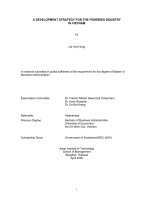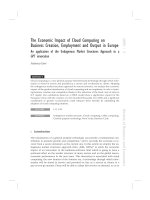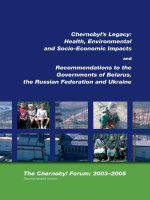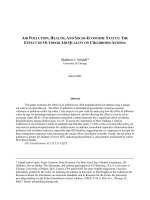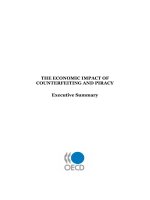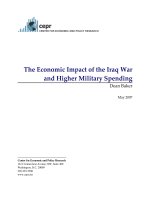Agricultural and Socio Economic Impact of Green River Project in Nigeria
Bạn đang xem bản rút gọn của tài liệu. Xem và tải ngay bản đầy đủ của tài liệu tại đây (84.8 KB, 6 trang )
Agricultural and Socio-economic Impact of Green River Project in Rural
Communities of Imo State, Nigeria
Nlerum, F.E. B.I. Isife and C. O. Albert
Department of Agricultural and Applied Economics/Extension,
Rivers State University of Science and Technology, P.M.B 5080,
Port Harcourt, Nigeria. E-mail:
ABSTRACT
This study determined the agricultural and
social impact of the Green River Project
(GRP) in Imo State, Nigeria. The interview
schedule was used in eliciting data from a
sample size of 90 randomly selected
beneficiaries of the Project. Data were
analyzed with the impact measuring model,
Wilcoxon signed-rank test and percentage.
The Project made a higher impact in all the
six agricultural indicators studied. The
Project also made a higher impact in ten and
low impact in nine socio-economic indicators
analyzed. There was no significant
difference in impact between within and
before
Project
intervention
among
beneficiaries. The study recommends
improvement in storage facilities, supply of
farm inputs and delivery of micro-credit to
beneficiaries by the Project to increase
higher impact and improve areas of low
impact in the State.
INTRODUCTION
The Green River Project (GRP) is an
agricultural extension programme of the
Nigeria Agip Oil Company (NAOC). GRP
was established to address the complaint
raised by the states of the Niger Delta region
that the pollution from oil and gas
exploration and exploitation badly affected
their ecosystem (Ofuoke et al., 2005 and
Amaniyie, 2006). According to the above
authors, agriculture which is the major
occupation and main source of income to
rural indigenes of the Niger Delta states was
negatively affected. An earlier study of
Nnodim and Isife (2004) reported that many
farmlands, economic crops and trees and
fishing waters in the region were rendered
barren. The resultant effect left the rural
people with untold hardship, poverty
(Wangbu, 2005) and subsequent poor socioeconomic standing.
International Journal of Rural
Studies (IJRS)
ISSN 1023–2001
The Green River Project was established to
facilitate the development of a strong food
production system among the host
communities to the oil and gas exploration
and exploitation of the Nigeria Agip Oil
Company (GRP 2007). This vision included
the promotion of growth in crops, livestock,
fisheries and forestry, which were expected
to result in a sustained improvement in
agricultural
production,
employment,
standard of living and poverty reduction
among the members of its host states which
are Bayelsa, Delta, Imo and Rivers.
Presently, GRP is responding to the
agricultural and socio-economic needs of its
clientele in Imo State in line with its
objectives, which according to ARMT (1993)
are
improvement
in
the
traditional
agricultural system by means of an
extension service, distribution of improved
varieties of the main food crops grown in the
area and the introduction of new crops of
nutritional and economic interest to the
people.
The
GRP
objectives
were
implemented through its designated units
which according to GRP (2005) are
extension services, plant propagation, soil
laboratory unit, livestock, micro-credit, farm
mechanization, skill acquisition, fisheries
and agro-processing units.
The activities of GRP in Imo State which
were aimed at better agricultural production,
improved socio-economic status and poverty
alleviation of the people are in conformity
with the aims of current national and
international development agencies (Eni
Nigeria News 2007) such as the National
Economic
Empowerment
Development
Strategy
(NEEDS),
National
Poverty
Alleviation Programme (NAPEP), Niger
Delta Regional Development Master Plan
(NDRDMP), New Partnership for African
Development (NEPAD) and the Millennium
Development Goals (MDGs).
vol. 19 no. 1 April 2012
www.vri-online.org.uk/ijrs
Article 6 Page 1 of 6
Despite the presence of GRP and its
subsequent activities to raise the agricultural
production capacity and socio-economic
condition of its rural host communities, the
NDRDMP (2006) reported widespread
poverty in Niger Delta with close to 70% of
the population living below the poverty line.
This study was designed to investigate the
extent to which GRP has been able to
address the agricultural and socio-economic
needs of its rural beneficiaries in Imo state.
The study objectives determined the
agricultural and socio-economic impact of
GRP and the problems faced by
beneficiaries. The arising hypothesis was
that, there is no significant difference
between within and before Project
intervention in the agricultural and socioeconomic status of Project beneficiaries in
the State.
RESEARCH METHODOLOGY
This study was carried out in Imo State,
Nigeria which lies within latitudes 40 45´N
and 7015´N and longitude 6050´E and 7025´E
with an area of around 5,100 square
kilometers and bordered by Abia State on
the east, Rivers Niger and Delta State on
the west, by Anambra State to the north and
Rivers State to the south (Imo StateWikipedia, 2011). Agricultural production is
the major occupation of the people. Yam,
cassava, maize and rice are the major
staple food crops. Oil palm is its main cash
crop. Petroleum and gas in the state made
possible the presence of the Nigerian Agip
Oil Company and hence the Green River
Project.
Data for the study were collected with the
interview schedule which elicited data for
five years before and five years of
participating in the Project. The sample size
was 90 beneficiaries who were randomly
drawn from the list of beneficiaries of the
Project. Thirty respondents were sampled
from the communities of Egbema, Ohaji and
Oguta by enumerators who were previously
trained for this purpose.
The impact measuring model of Freeman et
al., (1979) which was cited by Nwachukwu
(2008) states that the impact (O 1) of a
project is determined by the score on
measurement after intervention (E 2) minus
the score on measurement before
intervention
(E1).
The
model
is
mathematically present as:
O1 = E2 – E1 … 1. Where O1 = Impact, E2 =
Score of variable achieved within project
participation and E1 = Score of the same
variable
achieved
before
project
participation.
As a decision rule, positive outcomes from
the above model were read off as higher
impact, while negative outcomes were read
off as low impact for each variable. Impact
for farm size, wet cassava root and maize
grains per beneficiary were estimated in
football fields, the farmers’ full bags and full
head pans respectively. These were
converted into tonnes per season as follows:
i) Farm Size: Two football fields were
approximated to be equal to one hectare.
The total football fields achieved by all
respondents were converted into hectares
by dividing by two. The outcome was then
divided by the total number of respondents
to obtain the mean farm size per
respondent.
ii) Wet cassava root: A farmer’s full bag
weighed 100 kilogramme (0.1 tonne). This
value was used to multiply the total number
of bags produced by all respondents. The
outcome was then divided by the total
number of respondents to obtain the mean
in tonnes of wet cassava root per
respondent in a year.
iii) Maize grains: One full head pan weighed
10 kilogrammes (0.01 tonne). This value
(0.01tonne) was used to multiply the total
head pans produced by all respondents and
divided by total respondents to obtain the
mean in tonnes of maize grains produced by
a respondent in a year.
The Wilcoxon signed-rank test which was
used
for
hypothesis
testing
is
mathematically presented as:
Analyses of data were achieved with the
impact
evaluation
measuring
model,
Wilcoxon signed-rank test and percentage.
International Journal of Rural
Studies (IJRS)
ISSN 1023–2001
vol. 19 no. 1 April 2012
www.vri-online.org.uk/ijrs
Article 6 Page 2 of 6
T − n (n + 1)
Z=
4
n(n + 1) (2n + 1)
24
where: T = Absolute sum of negative rank of
difference in variables before and within
participation in the Project.
N = Number of variables (25
variables in this case)
Z = Wilcoxon test value (impact)
RESULTS AND DISCUSSION
Findings in Table 1 show that the Project
recorded a higher impact in 16 and low
impact in 9 out of 25 agricultural and socioeconomic indicators studied. Specifically, the
Project made a high impact of 1.88 hectares
as the mean farm size per participating
farmer. This result agreed with that of Ajayi
and Ogba (2006) where the intervention of
the Water Aid Project (WAP) led to an
increase in farm size per participant from 3.8
hectares before Project to 4.6 hectares after.
The WAP impact value of 0.8 hectares on its
beneficiaries however was lower than the
impact of 1.88 hectares made by GRP on its
own beneficiaries. The result further
indicated a higher impact of over two
animals per herd size of sheep and goat per
farmer. All other agricultural variables as
shown in Table 1 indicated higher impact of
the Project among the studied beneficiaries.
Socio-economically, out of the five variables
studied
under
household
equipment
purchased by beneficiaries, the Project
made low impact in four as in Table 1.
Higher impact was however achieved in one
variable (mobile phone purchase). This
appears to imply that the Project is assisting
beneficiaries foster a better means of
communication among themselves, the
Project’s Extension Officers and the world
around them. Also, out of the five variables
studied under mobility purchased, the
Project made low impact in bicycle and
motor cycle and a higher impact in canoe,
engine boat and any four-wheeled vehicle.
This higher mean impact in vehicles
purchased agreed with the findings of
Ashimolowo et al., (2005), where 17.5% of
small scale farmers were able to purchase
cars of their own following an intervention
with a micro credit scheme extended to
them. These farmers had 0% in car
purchase before the micro-credit scheme
intervention according to the above authors.
Table 1: Project Impact on Agricultural and Socio-economic Variables in Imo State
Variables
Achievement
Before Project
With Project
Impact
(1997-2002)
(2003-2008)
(E1)
(E2)
(O1)
0.94
2.56
0.11
2.82
5.43
1.53
1.88
2.87
1.42
2.77
5.91
3.14
0.39
0.71
0.31
0.26
1.00
0.74
Agricultural
Mean farm size per farmer (counted in hectares)
Mean sheep/goat size per farmer (herd count)
Mean fishpond number per farmer
Mean annual yield of wet cassava root per
farmer (tonnes)
Mean annual yield of maize grain per farmer
(tonnes)
Mean number of membership in farmers
co-operative society
Socio-economic
International Journal of Rural
Studies (IJRS)
ISSN 1023–2001
vol. 19 no. 1 April 2012
www.vri-online.org.uk/ijrs
Article 6 Page 3 of 6
Household equipment purchased (item
count)
Radio
Television
Video machine
Set of upholstery chairs
Mobile telephone
Mobility purchased (item count)
Bicycle
Motor cycle
Canoe
Engine boat
Any four-wheeled vehicle
Shelter built (item count)
69
44
36
28
9
10
22
28
22
32
-59
-22
-8
-6
23
44
18
15
5
10
6
6
22
8
11
-38
-12
7
3
1
Mud/thatch house
22
10
-12
Mud/zinc house
22
16
-6
Block/zinc house
26
24
-2
16
25
9
11
10
9
15
12
18
16
22
19
21
7
6
13
4
9
Gathering materials for block/zinc house
construction
Savings and investment (item count)
Opened Bank Account
Opened Fixed Deposit Account
Purchased Share
Participate in Contribution (ntu)
Purchased Land
Source: Field Survey, 2009
Further socio-economic results in Table 1
indicate that low impact was recorded in
three out of the four variables studied under
shelter built. High impact was recorded in
the gathering of materials for construction of
block/zinc houses among the Project
beneficiaries. This appears to mean that if
the Project is sustained, more beneficiaries
would acquire enough financial resources to
gather building materials that would result in
the construction of modern houses of their
own in agreement with the findings of
Ashimolowo et al., (2005) where built
houses ranged from unplastered to painted
after participating in a micro-credit
intervention in their farming enterprise. The
International Journal of Rural
Studies (IJRS)
ISSN 1023–2001
above authors showed that houses were not
built by the same farmers before their
exposure to the micro-credit scheme.
Table 1 also showed that the Project made
higher impact on beneficiaries in all the five
variables studied under savings and
investment. These are opened bank
account, opened fixed deposit account,
purchased share, participated in contribution
(ntu) and purchased land. This finding
suggests that the Project is assisting in
increasing the economic activities of its
beneficiaries in Imo State.
vol. 19 no. 1 April 2012
www.vri-online.org.uk/ijrs
Article 6 Page 4 of 6
Table 2: Summary of Wilcoxon Signed-Rank Test Showing Differences in Impact Within
and Before Project Activities
Subject
Ranks
Number of Sum of
Mean
Wilcoxon
Variables
Ranks
Rank
Test
(N)
Statistics
Impact within minus (-) impact
Negative
9
174
19.33
before Project activities
Positive
16
228.5
14.28
Ties
0
Total
25
Z (calculated)
0.3091
Z (tabulated)
0.4989
Source: Field Survey, 2009. Alfa = 0.05
Table 2 showed that Zcal (0.3091) was less
than Ztab (0.4989) at an alfa level of 0.05.
Given this non significant result, we
accepted the null hypothesis and concluded
that there was no significant difference
between within and before Project
intervention in the agricultural and socioeconomic status of the Project beneficiaries
in Imo State. This result implied that,
although the Project intervention resulted in
the achievement of more positive impact in
16 variables as against a negative impact in
9 variables, out of the 25 variables that were
studied, the magnitude of the positive impact
was not high enough to result in a mean that
would bring about significant change in the
agricultural and socio-economic status of the
respondents.
Table 3: Percentage Distribution of Militating Problems of Beneficiaries of the Project in
Imo State (n=90)
S/No
Problems
Percentage (%)
1.
Poor crop output of Project introduced new species
24.4
2.
Poor income from Project introduced new species
34.4
3.
Late arrival of supplied Project inputs
57.8
4.
Poor quality of Project supplied farm inputs
52.2
5.
Inadequate supply of inputs by Project
70.0
6.
Inadequate market for farm products
67.8
7.
Insufficient storage facilities for farm products
71.1
8.
Inaccessibility to Project micro-credit facilities
70.0
9.
Insufficient contact with Project Extension Officers
54.4
10.
Incompatibility of recommendation with existing farming system
41.1
11.
Inadequate farmers’ participation in technology selection
41.1
Source: Field Survey, 2009. Multiple responses were used.
Table 3 indicated that the highest problem
faced by Project beneficiaries as indicated
by 71.1% of the respondents was insufficient
storage facilities for their farm products. This
finding agreed with the study of Isife, et al.,
(2006). Next were inadequate supplies of
inputs by the Project as indicated by 70.0%
and inaccessibility to the Project’s microcredit facility as also indicated by 70.0% of
the respondents. The effect of these major
problems and others explain why there was
International Journal of Rural
Studies (IJRS)
ISSN 1023–2001
no significant difference between within and
before Project intervention in the state.
CONCLUSION AND RECOMMENDATION
The Green River Project has shown
evidence of higher impact in the agricultural
and
socio-economic
status
of
its
beneficiaries in Imo State in all the six
agricultural indicators examined in this
study. Out of the nineteen socio-economic
indicators analyzed, the Project made a
higher impact in ten and a low impact in
vol. 19 no. 1 April 2012
www.vri-online.org.uk/ijrs
Article 6 Page 5 of 6
nine. The result of the test of hypothesis
showed no significant difference in impact
between within and before Project
intervention. The study recommends efforts
that would increase the magnitude in values
of its achieved higher impact and
improvement in its area of low impact.
Improvement in the storage facilities of farm
products, supply of farm input and delivery
of micro credits by the Project would
increase the magnitude of its higher impact
among beneficiaries.
Nwachukwu, I. (2008). Planning and Evaluation of
Agricultural and Rural Development Projects. Umuahia,
Lamb House Publishers, Nigeria, 74 p.
Ofuoku, A. U., J. U. Agbamu, G. N. Emah and A. U,
Nnodim (2005). “Youth Restiveness in Delta State as
Perceived by Community Development Committees
and Implications for Agricultural Development”. Journal
of Agriculture and Social Research, 5 (2): 27-35.
Wangbu, J. (2005). Niger Delta: Rich Region, Poor
People. Enugu, Snaap Press Limited, Nigeria, pp 1156.
REFERENCES
Amanyie, V. (2006). The Struggle of the Niger Delta,
Nigeria. Owerri, Springfield Publishers Limited, pp. xvixviii.
ARMTI, (1993). Agricultural and Rural Management
Training Institute, Quarterly Monitoring Project on
Nigerian Agip Oil Company (NAOC) – Green River
Project. Ilorin, Nigeria. October to December, 1993, pp
1-27.
Ashimolowo, O.R, L.A Akinbile and E.A. Afolayan
(2005). Effect of Micro-credit on Small Scale Crop
Farmers in Odeda Local Government Area of Ogun
State. Proceeding of 10th Annual National Conference
of Agricultural Extension Society of Nigeria. (14-17
June, 2005) at Badegi, Niger State Nigeria, pp. 86-91.
Eni Nigeria News (2007). “Community Development”.
In-house Journal of, Nigerian Agip Oil Company
(NAOC) Limited, Nigeria Agip Exploration (NAE)
Limited and Agip Energy and Natural Resources
(AENR), Limited, July-Sept. 4 (2):11-15.
Freeman, H. E., P. H. Rossi, and S. R. Wright (1979).
Evaluating Social Projects in Developing Countries.
Organization
for
Economic
Co-operation
and
Development.
GRP (2005). Green River Project, Nigerian Agip Oil
Company Limited, Impact Evaluation, April, 2005, 117
p.
GRP (2007). Green River Project, 12th Nigerian Agip Oil
Company (NAOC) – GRP Farmer’s Day Celebration,
December 1st 2007, pp 1-6.
Imo State-wikipedia (2011). The Free Encyclopedia,
en.wikipedia.org/wiki/Imo_State, Accessed on 2nd of
February, 2011.
NDRDMP (2006). Niger Delta Regional Development
Master Plan, The Popular Version, Niger Delta
Development Commission, pp 1-25.
Nnodim, U. A and B. I. Isife, (2004). “Assessment of
Shell Petroleum Development Company Extension
Services in Etche Local Government Area of Rivers
State, Nigeria”.
Journal of Agriculture and social
Research, www.inap. Info/ajol, 4(2): 19-23.
International Journal of Rural
Studies (IJRS)
ISSN 1023–2001
vol. 19 no. 1 April 2012
www.vri-online.org.uk/ijrs
Article 6 Page 6 of 6
